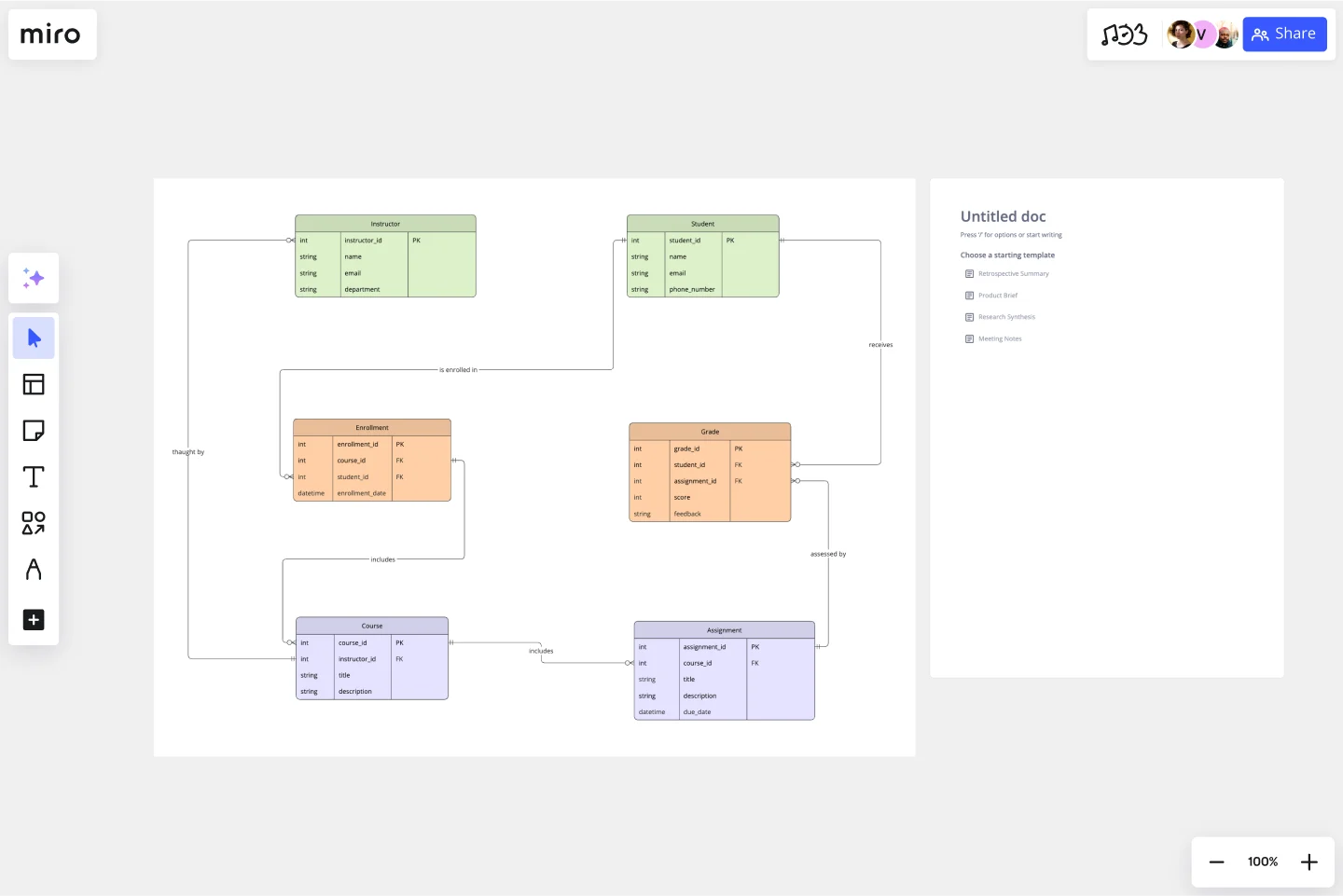ERD Educational Learning Management System Template
Create a clear visual representation of the LMS structure and facilitate planning with the ERD Educational Learning Management System Template.
Available on Enterprise, Business, Education plans.
About the ERD Educational Learning Management System Template
The ERD (Entity-Relationship Diagram) Educational Learning Management System Template is crafted to help educators and administrators visualize the structure of their learning management systems. It outlines the key entities such as Students, Courses, Instructors, Assignments, and Grades, and the relationships between them. This model is particularly useful for institutions adapting to various modes of instruction, including online and hybrid classrooms, as it aids in managing course offerings, student enrollments, academic performance, and resource allocation.
How to use the ERD Educational Learning Management System Template
Customize entities: Start by identifying the key entities relevant to your LMS. Use the pre-defined entities like Student, Course, Instructor, Assignment, and Grade, or add new ones as needed.
Define relationships: Connect the entities using lines to define the relationships between them. For example, link Students to Courses they are enrolled in, or Assignments to the Courses they belong to.
Add attributes: For each entity, add attributes that detail the information stored. For instance, a Student entity might have attributes like Student ID, Name, and Email.
Collaborate and share: Invite team members to collaborate on the diagram by sharing the board link. Use Miro's commenting and @mention features to gather feedback and refine your ERD.
Finalize and implement: Once your ERD is complete, use it as a blueprint to develop or enhance your Learning Management System. Export the diagram for documentation or presentation purposes.
Why use the ERD Educational Learning Management System Template
Using the ERD Educational Learning Management System template in Miro has several benefits:
Clarity and organization: It provides a clear visual representation of the LMS structure, making it easier to understand and manage.
Efficient planning: This template helps in the efficient planning and implementation of LMS features by identifying key entities and their relationships.
Collaboration: Facilitates collaboration among educators, administrators, and IT professionals. It allows multiple stakeholders to work together in real time, ensuring that everyone is on the same page regarding the structure and functionality of the learning management system. This collaborative approach not only speeds up the decision-making process but also enhances the quality of the educational experience provided.
Enhanced communication: The template enables clear and effective communication among team members, which is crucial for the successful implementation and management of any LMS.
Flexibility and scalability: As educational institutions grow and evolve, their LMS needs to adapt. The ERD template makes it easier to identify areas for expansion or modification, ensuring the system can scale with the institution.
Time and cost efficiency: The template provides a clear roadmap for LMS development and management, helping reduce the time and resources required to maintain and update the system.
The ERD Educational Learning Management System Template is an invaluable tool for anyone involved in the education sector. It not only provides clarity and organization but also supports efficient planning, fosters collaboration, and ensures the LMS can grow and adapt to meet future needs. By using this template in Miro, educational institutions can enhance their learning management systems, ultimately improving the educational experience for both instructors and students.
Get started with this template right now. Available on Enterprise, Business, Education plans.
Service Blueprint by Hyperact
Works best for:
Research & Design
The Service Blueprint template is perfect for visualizing the orchestration of service components. It maps out frontstage and backstage elements, helping you analyze and enhance customer experiences. Use this template to align teams, identify pain points, and streamline processes, ensuring a seamless service delivery. It's ideal for creating a shared understanding of service dynamics among stakeholders and collaborators.
Project Status Report Template
Works best for:
Project Management, Documentation, Project Planning
When a project is in motion, the project manager must keep clients and shareholders updated on the project’s progress. Rather than waste time with constant meetings, leaders can send out weekly or daily project status reports to keep everyone informed. You can use the Project Status Report Template to streamline the report creation and distribution process.
Cloudflare RAG Architecture Knowledge Seeding Template
The Cloudflare RAG Architecture Knowledge Seeding template in Miro streamlines the sharing and visualization of cloud architecture knowledge, making it ideal for tasks like cloud infrastructure optimization and diagram creation. This template enables straightforward documentation and collaboration, ensuring complex information is accessible to all team members.
ERD Blogging System Template
Works best for:
ERD
The ERD Blogging System template in Miro efficiently manages and organizes digital content. It features key entities such as User, Post, Comment, Category, Tag, and File, which are essential for managing the creation and publication of blog posts, engaging users through comments, and organizing content via categories and tags. Additionally, it supports media attachments through the File entity, linking them to the relevant content. This template helps streamline the blogging process, making it an invaluable tool for content management and publication.
Datavant Switchboard with AWS Clean Rooms Template
Works best for:
AWS
The AWS Datavant Switchboard Clean Rooms Template integrates health data sources using Datavant's secure data connection capabilities and AWS Clean Rooms' scalable data processing environment. It's useful for professionals in engineering, database management, and development. The customizable Miro interface streamlines secure and efficient data handling and team collaboration for a wide range of projects.
4-Circle Venn Diagram Template
Works best for:
Diagramming, Mapping, Brainstorming
The 4-Circle Venn Diagram Template has an easy, interactive, and dynamic way to visualize complex relationships between data sets. Empower your team's collaboration and communication with this powerful tool.
